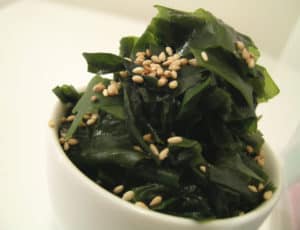 To some of us, seaweed is just that annoying stuff that you gingerly step around when walking the beach, but for others, it’s on tonight’s dinner plate. Seaweeds, sometimes called sea vegetables, have been a traditional food in China, Japan and the Republic of Korea, and are frequently used as a salad ingredient in Indonesia and Malaysia. Other people who live close to the oceans (various European and Nordic countries) have also a history of harvesting and eating local sea vegetables. Along the northeast coast of the U.S. as well as New Brunswick and Nova Scotia, seaweed companies are growing their businesses rapidly as food manufacturers discover that the public is becoming interested in the taste as well as the potential health benefits of sea vegetables. Eating seaweed isn’t something new in the U.S. and Canada, but it is becoming more popular as people learn more about these abundant sea vegetables. Last year Maine hosted its first Seaweed Festival to help spread the word.
To some of us, seaweed is just that annoying stuff that you gingerly step around when walking the beach, but for others, it’s on tonight’s dinner plate. Seaweeds, sometimes called sea vegetables, have been a traditional food in China, Japan and the Republic of Korea, and are frequently used as a salad ingredient in Indonesia and Malaysia. Other people who live close to the oceans (various European and Nordic countries) have also a history of harvesting and eating local sea vegetables. Along the northeast coast of the U.S. as well as New Brunswick and Nova Scotia, seaweed companies are growing their businesses rapidly as food manufacturers discover that the public is becoming interested in the taste as well as the potential health benefits of sea vegetables. Eating seaweed isn’t something new in the U.S. and Canada, but it is becoming more popular as people learn more about these abundant sea vegetables. Last year Maine hosted its first Seaweed Festival to help spread the word.
Seaweed Savvy
Seaweed is from the algae family and there are many types, though only some are routinely consumed. The types that you’re likely to find made into snack foods, energy bars, salads, on restaurant menus and sometimes in store aisles include:
- Nori — also called laver, these are the thin, dark green/black seaweed sheets most commonly used to wrap sushi rolls
- Kelp — this type is frequently found in flake form
- Wakame — similar to kombu, it’s frequently used in Japanese miso soup
- Dulse — this red seaweed can be found either whole or as flakes. Whole dulse needs soaking before incorporating it into recipes, while the flakes are good to go as they are
- Kombu — typically found in strips and is used in the indispensible “dashi” stock due to its ability to act as a flavor enhancer (it’s extremely high in the amino acid glutamate, which is at the heart of the umami, or savory, taste)
- Arame — a lacy, mild seaweed that’s almost noodle-like in texture when rehydrated (rather like angel hair pasta)
Seaweed Nutrition
Sea vegetables are highly nutritious, but because typically only small amounts are consumed, they may not be a big contributor to overall nutrition for Westerners. Seaweeds are low in calories and fat and high in fiber, but their biggest claim to nutritional fame is probably the very wide array of minerals they contain. Sea vegetables are especially rich in iodine, which is important for a properly functioning thyroid gland. Iodine deficiency adversely impacts growth, brain development, nervous system function and metabolism, among other things. Seafood and sea vegetables are rich in iodine, and the amount varies especially for seaweed. The iodine content of foods grown on land varies due to the iodine content of the soil.
Another component of seaweed that is getting more attention lately, is fucoidan, a natural type of carbohydrate present in many types of brown seaweed. Research indicates that fucoidan has some anti-cancer effects, though that research was not conducted with humans or animals, so it’s still early to make any firm conclusions. However, ongoing research on fucoidan in seaweed suggests it may have possible benefits in a variety of areas, though most notably for enhancing immunity, fighting inflammation and acting as an anti-coagulant (for that reason, those on blood thinning medications are cautioned against the consumption of fucoidan supplements or brown seaweeds).
Where do I find seaweed in the store?
Mainstream supermarkets are not known as major sea vegetable outlets, although the popular nori sheets are commonly available near the Asian food ingredients in many markets. Aside from making sushi rolls with them, these sheets can be cut into strips and easily sprinkled on lots of different foods for added taste and texture, or combined with sesame seeds and sea salt, toasted in a skillet and then pulverized in a food processor to make a homemade version of the Japanese seasoning gamasio (sprinkle it over rice, veggies, soup or stir-fry or other mixed dishes). Increasingly, you can find snack foods and crackers made with seaweed as well—check for them in the Nature’s Place aisle at your local Hannaford store.